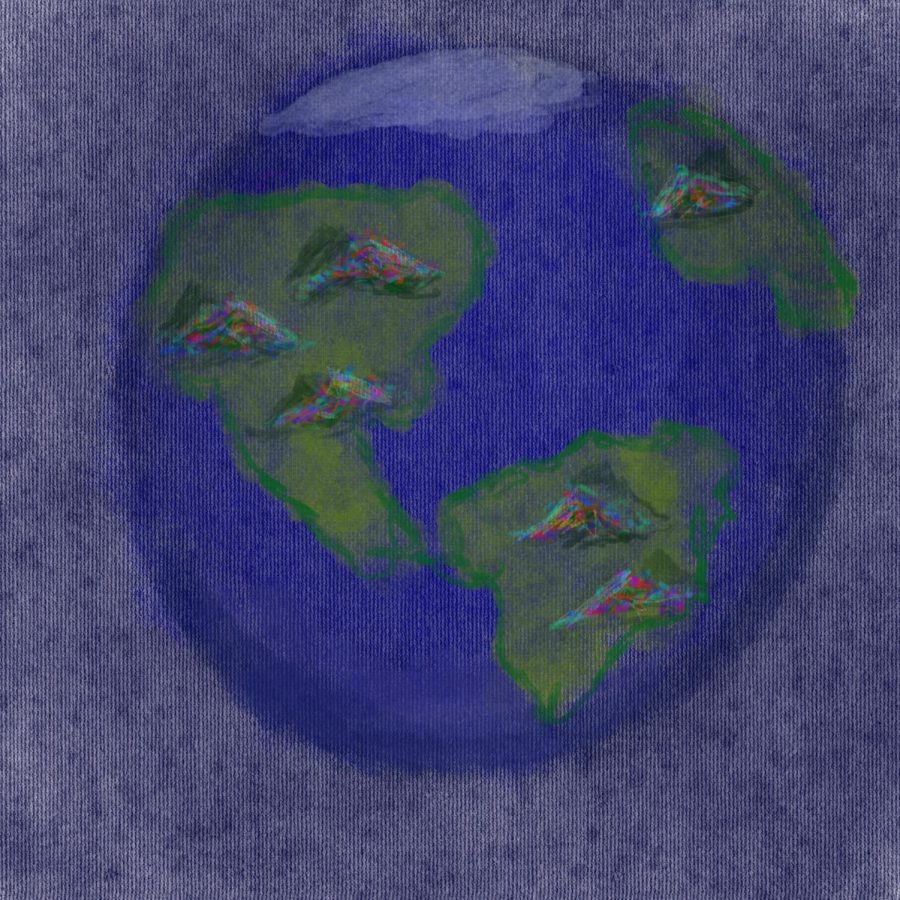Zero Waste Companies Repurpose Scraps of Fabric Into Luxury Clothing
This is an artistic portrayal of ‘Textile Wastes on Earth,’ symbolizing the magnitude of the problem. Original artwork by Ashley Lim ’22.
Think about how a shirt is made: a stencil of the shirt is placed on a sheet of fabric. The stencil is then traced onto the fabric and finally cut out. What happens to the leftover fabric around it? Obviously, one should try her best to minimize the waste by piecing together multiple stencils on the sheet of fabric, but because of the awkward geometric shape of most clothes, there will always be scraps left behind. These scraps are what many large manufacturers throw out, and while the scraps may seem small if you measure the amount from a single shirt, they accumulate into large piles when shirts are mass produced.
Large manufacturers waste gallons of water and heaps of fabric in order to create clothes. 93 billion cubic meters of water are needed for textile production, which roughly translates to 2,700 liters of water for a single cotton shirt. Not only are tons of water wasted, but also tons of scraps. In 2017 alone, 3.2 million tons of textile waste was taken into landfills.
Andagain ( @andagainco on Instagram) is one of many eco-friendly brands that are working towards becoming a sustainable, zero waste company. Andagain was founded in 2017 by Morgan Young and Greg Harder with the hopes of creating luxury clothes without wasting resources. Located in Los Angeles, California, this company utilizes leftover and vintage fabric bought from secondhand vintage shops to rework them into beautiful luxury pieces.
When they create their pieces, they save all of their scraps in a pile. With these scraps, they then use them in their next piece through their unique ‘zero waste textile’ technique. This technique is brilliant –- the Andagain textile artists stuff scraps into a pocket of clear vinyl fabric and then cross stitch multiple times over this pocket, locking all the scraps into place and creating an entirely new sheet of material. The transparent material allows us to see all the little scraps trapped inside, and since scrap colors and sizes vary, each sheet of new fabric is different from the next. Whatever scrap is left over from this project is used for the next, and again, hence their corporate name, ‘Andagain.’
Many more brands have also been inspired to do the same. Zero Waste Daniel ( @zerowastedaniel on Instagram) is another company that similarly recycles fabrics with the intentions of promoting sustainable fashion. Daniel Silverstein, the founder, visits dumps where textile wastes are discarded, collects these textile wastes, and then creates patchwork textiles in order to make new clothes.
“When you’re making cookies, what you would do is take all the leftovers and roll them out again and cut more cookies,” Silverstein explained. “[The] fashion industry throws out the leftovers, but I make new fabric in what I call ‘reroll.’” Daniel’s brand is much more affordable than Andagain, allowing more consumers to support his brand and his work.
With the rise of sustainable fashion labels, this raises the question: why has this not been done sooner? Actually, environmentally-friendly brands date back to as early as the 1990s. Within the past four years, there has been a peak in interest, with more businesses and consumers understanding the importance of reducing waste and contributing to our fragile Earth’s recovery.
Would consumers purchase the same product from smaller sustainable companies if it meant that they had to pay more? A poll that I conducted showed that out of 110 Bronx Science teenagers, 91% would still support sustainable businesses, even if it meant that clothing products are more expensive than similar cheaper products by non-sustainable companies. So clearly there is consumer demand for sustainable fashion, even if it costs a bit more for the consumer.
However, not everyone can spend lots of money on zero waste clothes, with some garments priced at over $1,000 USD. An alternative would be for people to purchase from clothing stores that have eco-friendly packaging. Even if this purchase does not reflect a true ‘zero waste’ item of clothing, it would still be a step in the right direction towards helping our planet in terms of environmentally sustainable practices. Adjustments like these are a great step forward for our planet, and we must remain hopeful that this idea will resonate throughout the world by means of the butterfly effect.
Environmentally-friendly brands date back to as early as the 1990s. Within the past four years, there has been a peak in interest, with more businesses and consumers understanding the importance of reducing waste and contributing to our Earth’s recovery.
Ashley Lim is a Copy Chief for 'The Observatory' yearbook. She finds journalism to be a brilliant form of writing that reaches readers in an informative,...

